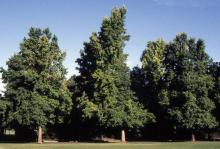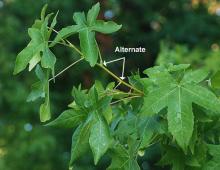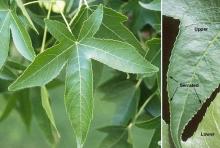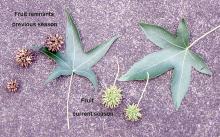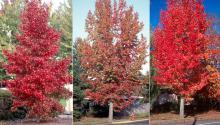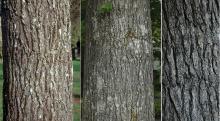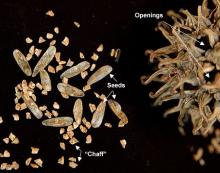Liquidambar styraciflua
Common name:
American Sweetgum
Pronunciation:
li-kwid-AM-bar sti-ra-si-FLOO-a
Family:
Hamamelidaceae
Genus:
Type:
Broadleaf
Native to (or naturalized in) Oregon:
No
- Broadleaf deciduous tree, 60-75+(150) ft [18-23(45) m] high, pyramidal to oblong crown (excurrent). Stems rounded to somewhat angled, often developing corky wings. Leaves alternate, simple, blade 7-19 cm long and 5-16 cm wide, star-shaped, usually 5 lobed, sometimes 7, finely serrate lobes, deep glossy green above, paler below and without hairs (glabrous) except axillary tufts in major veins; "exhaling when bruised a pleasant resinous fragrance" (Sargent, 1922, p. 367); petioles 6-10 cm long, almost as long as the blade (total leaf length 11-25 cm) . Leaves are held late, and trees from seedlings have variable fall color, yellow, purple, or red. Fruit (capsules) aggregate to form a woody, mace-like cluster, about 3 cm across, green at first then brown when mature, persist into winter, surface openings release winged seeds, as many as 50 or more per fruit.
- Sun, best in deep, moist, slightly acid soils. May take several years for root system to establish during which shoot growth is limited. Surface roots lift sidewalks. Fruit may be messy (don't walk barefoot under the tree!).
- Hardy to USDA Zone 5, a few selections to Zone 4. Native from Connecticut to Florida, west to southern Ohio, Illinois, Texas, Mexico and into Central America.
- When the bark of sweetgum trees is peeled or injured a brownish yellow sap collects, this hardens into a gum or resin-like solid. In the pharmaeutical trade material is known as liquid-amber, or copalm balm, or storax. Native Americans used it medicinally as well as for chewing gum. They also made various teas and medicines to treat dysentery and diarrhea from the bark and roots of sweetgum. It is reported to be excellent for healing wounds.
-
A number of clones available, including columnar, variegated, deeply lobed forms, selections with excellent fall color, and a rounded-lobe form. Some of these include:
- Burgundy™ - narrow habit, leaves burgundy colored in late fall (November-December) and may remain on the tree into January.
- Emerald Sentinel® ('Clydesform') - narrowly pyramidal to columnar, dark green leaves, fall color yellow-orange to orange.
- Festival™ - tall, narrow, fall color golden with shades of peach and red.
- Gold Dust® - green leaves irregularly specked with yellow
- Happidaze™ ('Hapdell') - leaves glossy deep green, turn deep maroon in the fall, appears to be fruitless.
- 'Moraine' - broad oval shape, dark green leathery foliage which turns red and yellow in the fall, cold hardy to USDA Zone 4.
- Palo Alto™ - narrow, pyramidal form, fall color a brilliant orange-red, sometimes yellow.
- 'Rotundiloba' - leaf lobes rounded rather than pointed.
- 'Variegata' - Golden Sweetgum (apparently also offered as as 'Aurea', 'Aureum', 'Golden', Gold Dust®, or 'Golduzam') leaves light green and irregularly spotted and streaked with yellow, some half to three quarters yellow; in fall the yellow areas turn pink and the green areas red. Reportedly shows good cold hardiness and reduced fruit production compared to species.
- 'Worplesdon' - broadly pyramidal to oval, finger-like lobed leaves, foliage turns rich purple, orange and yellow in fall.
- Liquidambar: from the Latin liquidus, liquid, and ambar, amber, a reference to its fragrant resin. styraciflua: flowing with gum.
- Oregon State Univ. campus: several south and north of Cordley Hall. Found all over the campus and Corvallis, note variation in fall color.


